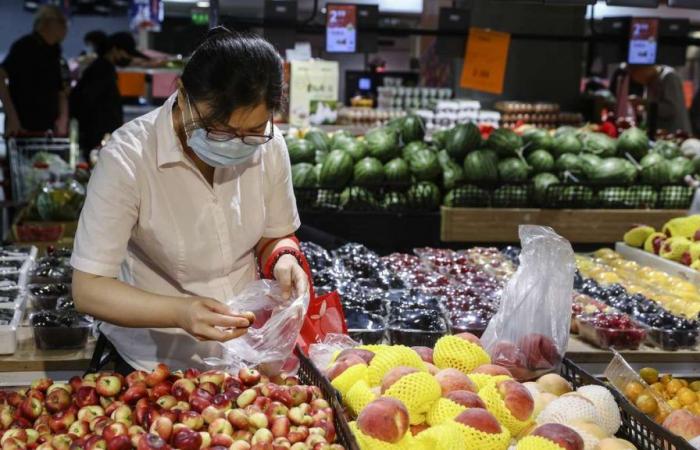Trade between Colombia and China moves about US$12 billion a year. Reference image.
Photo: EFE – WU HAO
Chinese families knew about avocado until about five years ago. In China, this fruit is consumed in a particular way: it does not accompany salads and it is unlikely to be found on the plate. It is usually not eaten, but drunk. Shipments from Mexico or Peru reach the food industries, which transform the avocado into juices and other packaged beverages for mass consumption.
At the same time, there is a frenzy for cherries in Chinese supermarkets. At the end of last year, the Asian giant received 88% of the exports of this fruit, most of which arrive from Chile. And between 2010 and 2023, China went from importing US$2 million to US$360 million of Uruguayan beef.
Fruits, meat and other agricultural products of Latin American origin are increasingly desired in China, a market of more than 1.4 billion consumers who are increasingly interested in “original and exotic” flavors, as explained Oscar Felipe Ruedapresident of Procolombia in China.
You may be interested in: Births in the first quarter were the lowest in the last decade
Could Colombian coffee, chocolates, confectionery or alcoholic beverages inspire success stories like those described above? For the director of Procolombia, the national agriculture has the conditions to increase its participation in the competitive Chinese market.
From Colombia comes a ship loaded with…
Trade between Colombia and China moves about US$12 billion a year. A figure that has behind it a deficit in balance: while the departure of goods from national ports leaves some US$2,000 million miscounted, the country buys approximately US$10,000 million in goods and services from China.
When taking only the output of Colombian products, data provided by Procolombia indicates that sales to the Asian giant grew by 0.1% last year.
Of the US$2,153 million in exports left by 2022, it was transferred to US$2,469 million at the end of 2023, which places China as the third most important commercial destination (after the United States and Panama).
A look at the basket shows that the mining-energy (such as coal or oil) They win by a landslide in this binational trade.
However, the 48.2% growth in agri-food sales to China from 2022 to 2023 is a sign that the Flows between Colombia and China could be changing.
“Of the total exports, to date 80% are mining-energy. Before these were 90% of the total basket. While miners go down, agroindustrial companies and other chains go up,” explains Óscar Felipe Rueda.
For the official, China’s current economy explains the recent diversification of Colombian exports.
In 2012, only 14% of urban households in that country were considered upper-middle class (income between US$16,000 and US$34,000 per year). 10 years later, 54% of households are in this range.
You may be interested in: This is how China’s economy reaches the middle of 2024: what risks are still latent?
“With all this going carbon neutral, China’s demand for coal has gone down. Furthermore, it is a country where the middle class is increasingly larger and has great purchasing power, with an urbanization process that continues, which drives demand for goods and services,” he adds.
The potential of the Chinese market
The Chinese consumer prospect is thrifty and appreciates local brands. But, fortunately for global trade, households are increasingly willing to pay for imported products that stand out for their quality, flavor or uniqueness.
Procolombia in China, as part of its work to promote Colombian exports, has detected opportunities for certain products within the so-called agri-food.
Colombian coffee, despite having to compete with high volumes of Brazilian beans and even with local cultivation in the province of Yunan, is recognized in China for its quality, flavor and aroma.
From 2022 to 2023, Colombian coffee exports to China grew by 60%, reaching US$142 million. How much could this market grow in the future? Although the average Chinese only drinks about six cups of coffee a year (in the United States it is 460 cups), the consumption of this drink is gaining popularity among new generations, which is why local chains such as Luckin Coffee have more than 16,000 stores in Chinese territory. or multinationals (like Starbucks) are regulars in cities like Beijing.
However, the roasted Colombian coffee bean (the presentation with the highest added value) He doesn’t have it so easy right now.
“We have seen that exports of green coffee increase and those of coffee derivatives and roasted coffee decrease. It is cheaper for the importer to bring green coffee, because the tariffs are lower, than to import it already roasted from Colombia,” acknowledges the director of Procolombia in China.
Beef, chocolates and rum
Thinking about how to boost Colombian exports to the land of the dragon goes hand in hand with compliance with regulations related to the phytosanitary admissibility of products. A process that can last more than a decade, just as happened with beef.
In June 2024, the first shipment of beef to China will arrive in China, which will join Uruguay or Brazil on the list of meat suppliers.
“We have high expectations. Brazil exports more than US$6 billion in meat and Uruguay more than US$350 million. China is a market with a very high demand for beef products. Colombia has two approved refrigerators that have already sent their first containers,” says Rueda.
But the profits of domestic producers could be lower than expected. Currently, the price of Chinese meat has dropped about 12% compared to a year ago.
You may be interested in: China no longer wants to produce “trinkets”: where are its manufacturing going?
“Although initially these Colombian companies expected to export about 50,000 tons of meat per year, they are already recalculating those quantities,” acknowledges Rueda, who insists that this is a short-term situation and will not affect shipments in the medium term.
Likewise, Procolombia expects moderate growth of 4% in the coming years for cocoa, thanks to the growth in Chinese demand for chocolate with a high content of this fruit. In this line, exports reached US$630,000 (7.5% more than in 2022).
Likewise, the consumption of alcoholic beverages is considered an integral part of Chinese culture. That is why there is an opportunity for, in addition to baijiu (Chinese liquor made from rice) or wine, the throats of the Chinese to be warmed by a drink of Colombian rum. Last year, China imported US$11 million of rum; Of these, Colombia exported US$567,000.
An FTA with China?
A binational trade with a growing trend, diplomatic relations in a good moment and several signed cooperation agreements are the factors that, par excellence, lead to the signing of a Free Trade Agreement (FTA).
Could the signing of an FTA between Colombia and China be considered to boost trade exchanges between these two countries as Chile, Peru or Costa Rica have already done?
The director of Procolombia recognizes that, although more instruments are needed to boost exports from Colombia and China, the solution should not be called “FTA.”
“The reality is that, if we want to remain competitive in the Chinese market and, above all, with those countries in the region with which we compete directly in many products (for example, with Ecuador in flowers) and increase our share of market, yes we must review a bilateral mechanism to boost sales”, points out the director of Procolombia in China.
In Mandarin, China is called ‘Zhong Guo’, which in Spanish translates as “central country”. Currently, national companies and government agencies are working together to improve pricing, packaging, marketing, health records and accessibility in order to increase shipments to the “center of the world.”
35 connecting flights (with an average duration of 34 hours) and 95 maritime routes (with transit times from 22 days) will facilitate the arrival in the second half of the first shipments of Colombian meat, guacamole and craft beer to the Asian country.






